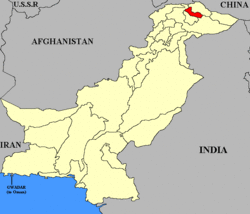Nagar (hill state)
| Nagar, Pakistan | |||||
| Princely state of Pakistan | |||||
|
|||||
| Map of Pakistan with Nagar highlighted | |||||
| Capital | Nagar, Pakistan | ||||
| History | |||||
| • | Established | 14th century | |||
| • | Disestablished | 25 September 1974 | |||
| Area | 5,000 km2(1,931 sq mi) | ||||
| Today part of | Gilgit-Baltistan, Pakistan | ||||
Nagar (Urdu: نگر, Riyasat Nagar) was a princely salute state in the northern part of Gilgit–Baltistan, Pakistan. Until August 1947, it was in a subsidiary alliance with British India. It bordered the states of the Gilgit Agency to the south and west, and the senior princely state of District Hunza to the north and east. From November 1947 to 1974 it was a princely state of Pakistan. The state capital was the town of Nagar.
The territory previously covered by Nagar forms three tehsils of the Nagar District of Northern Pakistan.
Nagar, founded in the fourteenth century, was an autonomous principality until the British gained control of the state following the Hunza–Nagar Campaign (1889-1893). It was a colonial princely state until 1947, but from 1868 it was a vassal of the Maharaja of Jammu and Kashmir, despite never being directly ruled by Kashmir. The rulers of Nagar were considered to be among the most loyal vassals of the Maharajas of Jammu and Kashmir, sending annual tributes to their Durbars until 1947. The British granted them a Hereditary gun salute of 15-guns
In November 1947, Nagar acceded to Pakistan, which became responsible for its external affairs and defense, while Nagar maintained internal self-government. In 1968, Syed Yahya Shah, the first educated politician of the valley, demanded civil rights from the Mir of Nagar. In 1974, when Ayub Khan's dictatorship ended in Pakistan and the Pakistan People's Party (under Zulfiqar Ali Bhutto) was elected, the government forced the Mir of Nagar to abdicate. The area was then merged with the Northern Areas.
...
Wikipedia

